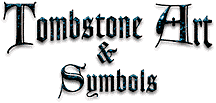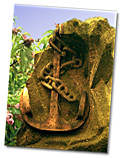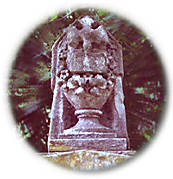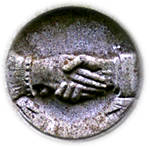
|

|
Anchor: Hope, or 'at rest' Not necessarily the last resting place of an old sea-dog, the anchor is an early Christian symbol and attribute of Pope Clement who, in the 1st century A.D., was bound to an anchor and cast into the sea. |  Anchor tombstone circa 1885, Abney Park Cemetery  Wrought iron-work design, Highgate Cemetery Arrow: | Mortality. Bed: | The deathbed Like the empty chair, the bed poignantly transforms a household object into a memento-mori. Book: | Faith everlasting Often seen embellished with a cross. Butterfly: | The resurrection In the folklore of many cultures, the butterfly is the incarnation of a man's soul. Circle: | Eternity A favourite motif of decorative ironwork and integral feature of the Celtic cross. Column: | Mortality The broken column traditionally signifies the break in life. Cross: | Christianity Usually mounted on three steps, signifying 'faith, hope and charity'. The most potent symbol of the Christian faith, the cross has been used for religious and ornamental purposes since time immemorial. To the Aztecs it symbolised the god of rain, the Scandinavians set them up as boundary markers, and two buns marked with a cross were found at the ancient Egyptian site of Herculaneum. In heraldry there are more than 285 varieties of cross, though only twelve are in common use, while the cross as a mystic symbol falls into four main categories: |
 Crown: | Heavenly reward Cypress Tree: | Deep mourning The cross of the crucifixion was allegedly constructed in part of Cypress. Once felled, a cypress never grows again.  Dove, book, & floral tribute headstone Highgate Cemetery Dove: | The soul - peace In Christian art the dove symbolises the Holy Ghost and is widely linked with the qualities of purity and holiness. Sometimes the bird is represented coming out of the mouths of saints at death. A European superstition asserts that no person can die peacefully while lying on a mattress or pillow which contains dove feathers and stricken people were laid on such down to delay the moment of death until relatives could be reached. Gates: | Heavenly entrance Hands: | Concord - farewell A symbol of fortitude in Ancient Egypt and of fidelity in Rome. The male and female clasping hands often seen on family graves represent the everlasting union of husband and wife.  Tombstone detail circa 1860, Kensal Green Cemetery  Heart: | Love & devotion The heart of the saviour. The flaming heart is a symbol of charity. Horse: | Courage or generosity An attribute of St George, St Martin, St Maurice & St Victor, all of whom are represented in Christian art on horseback. It is not uncommonly an emblem of catacombs. Hourglass: | The passage of life Often seen adorned with wings, the traditional symbol of Old Father Time. The scythe also frequently appears in funeral masonry and especally decorative ironwork.  | ||||||||||||